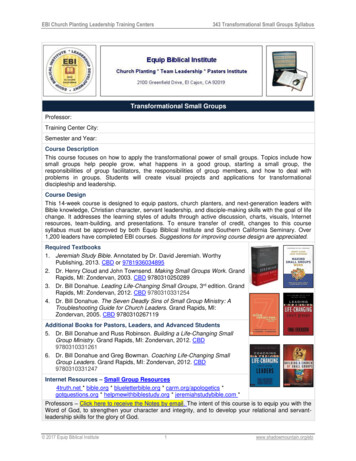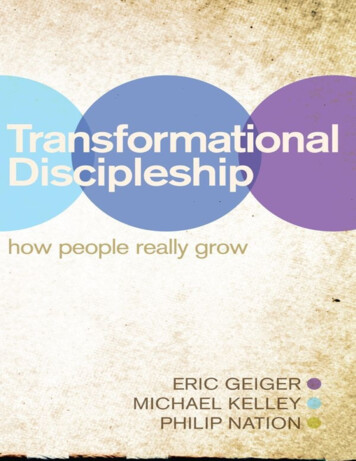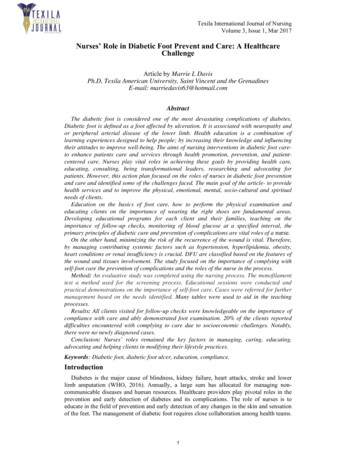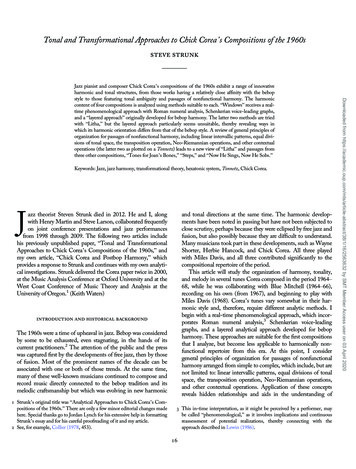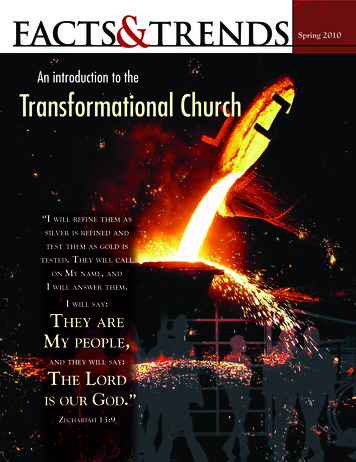
Transcription
Spring 2010An introduction to theTransformational Church“I will refine them assilver is refined andtest them as gold istested.They will callon My name, andI will answer them.I will say:They areMy people,and they will say:The Lordis ourGod.”Zechariah 13:9
June 28–July 2, 2010Glorieta, New MexicoLifeWay Glorieta Conference Center SUNDAY SCHOOLDISCIPLESHIP GROUPSJuly 23–26, 2010Ridgecrest, North CarolinaLifeWay Ridgecrest Conference Center SMALL GROUPSMISSIONAL GROUPSTraining is available for leaders of every age. You’ll discover the distinctives and best practices for each of thesegroups, learn how to use them in your church setting, and deploy them to make disciples. You’ll also enjoypowerful worship, great fellowship, and dynamic networking.Speakers: Lyman Coleman Dennis Pethers Jim Putman David Francis Bruce Raley Rick Howerton Jeff IorgWho should attend: Pastor Small-group Pastor Student Pastor Minister of Education Women’s and Men’s Ministers Children’s Minister Discipleship Pastor Lay LeadersLifeWay Conference Centers are family-friendly destinations with activities for all ages, so bring everybody!Both locations offer families the chance to relax, recharge, and rediscover each other in comfortableaccommodations. LifeWay Ridgecrest Conference Center, nestled in the Blue Ridge Mountains, is just minutesfrom Asheville, North Carolina, while LifeWay Glorieta Conference Center is tucked in the Sangre de CristoMountains at the southernmost part of the Rocky Mountain chain.Build great groups; see great growth!For more information and to register, go to www.lifeway.com/4G or call 800.254.2022.Visit www.lifeway.com/adults to learn more about building great groups in 2010.COMING SUMMER 2010!
Facts & Trends is published four timesa year by LifeWay Christian Resources ofthe Southern Baptist Convention. Facts& Trends is a free publication. Our goal isto help you carry out your ministry moreeffectively.Editorial staff:Polly House, editorKatie Shull, graphic designerKent Harville, visuals specialistBrooklyn Lowery, editor in chiefContentsVolume 56 Number 2 Spring 2010CommentaryFrom My Perspective: Hope and the American church.4LifeWay Research: First-generation immigrant study.6The Exchange: Who is not here?.43ArticlesA focus on transformation: A new initiative.10Ed Stetzer, contributing editorA focus on transformation: A letter from Bruce Raley .12Rob Phillips, director, communicationsEnd the VBS enlistment nightmare. 14Contact us:Mail: Facts & TrendsOne LifeWay PlazaNashville, TN 37234-0192E-mail: facts&trends@lifeway.comVBS music has Nashville connection.15VBS photo contest begins June 1.15Scripture memory: A missing discipline.16Nine steps to enhance church security.18KNOWN deepens students’ spiritual health.21Subscribe:Winter Fuge pastor has history at Glorieta.24Subscriptions to Facts & Trends are free.‘Inside LifeWay’ podcast: Is the New Testament reliable?.27To be added to our mailing list, pleasee-mail your name and address tofacts&trends@lifeway.com.Cover photo: Transformational Church is anew church health initiative from LifeWay.Churches can have a 2 ministry.28Father’s Day: In search of the perfect dad.32ResourcesFor you from LifeWay. 34Phone numbers, Web addresses and other contentreferenced in articles were verified at the time ofprinting, but are subject to change. When searchingthe Web, please use discretion.LifeWay Christian Resources is an entity of theSouthern Baptist Convention. It receives noCooperative Program funds but is self supportingthrough the saleof its resources.Bruce Raley 12VBS Preview 14Winter Fuge 24LifeWay.com/factsandtrends
From My PerspectiveThom S. Rainer, president and CEO, LifeWay Christian ResourcesHope and the American churchIspoke recently in a church that had a large number of college students. Indeed the presenceof the university in the town was so dominant that the community was best known as acollege town. After one of the worship services, a young college student sought me out. He justwanted to talk. The conversation was not that long, about 20 minutes; but it was of sufficientlength to introduce me to several facts about the college sophomore.He told me that he came from a middle-class home in a neighboring state. He was amiddle child, and had that quick wit that I notice in many middle children. Theyoung man was a finance major. Since that was my major in college many yearsago, we talked about the pros and cons of that academic path.The unspiritual generationNaturally, since we were in a church, our conversation moved tomatters of faith and spirituality. He shared with me that his parentsrarely attended church. There was certainly no expectation for him tobe in church as he grew up. Indeed, matters of spirituality were reallynever discussed in his home.At this point in the conversation, the young man fit well theprofile of the Millennials I have been studying for several months.My youngest son, Jess Rainer, and I are working on a book called“The Millennials,” which includes a massive survey of theolder portion of this generation. As a reminder, we date theMillennials’ birth years between 1980 and 2000.So when the young man told me that he grew up in anon-spiritual home, I was not surprised. Our study showedthat only 13 percent of this generation considers any formof spirituality important. Of course, my obvious questionasked why he was in church now. What moved himfrom no interest in spiritual matters to attending churchregularly?His response caused me to ponder.
Looking for hope“You know, Dr. Rainer,” he began. “There are so many reasons to be hopeless in this world. Youcan’t listen to or read anything without feeling a sense of hopelessness. I started attending thischurch because I was looking for hope.”Read that sentence one more time: “I started attending this church because I was looking forhope.”He then shared with me that he had visited several churches in his hometown looking for hope.His parents really didn’t mind one way or the other. But in each church he visited, he sensed asmuch hopelessness there as in the world beyond the churches. “It just seems that a lot of churchesare going through the motions. I could sense no life, especially no hope.”Our conversation concluded as I asked him what brought him to the university in the town. Ishould have anticipated his answer. He had visited the church where we were that day while he wasvisiting the school. It was the church that helped him decide to attend that particular university.“I guess I found a church with hope,” he said with a faint smile. “That’s why I’m at this schooltoday.”As I walked away, he asked me a question with total sincerity. “Do you have any idea why thereare so many hopeless churches today? It really seems counterintuitive.”When hope comes to churchIt is counterintuitive. We have the greatest Hope in the world. We have thepromise of the resurrection. We have Jesus.But we know the story. In too many churches “minors” become “majors” andfocus is lost. Critics outnumber the messengers of hope. And “that’s the way we’vealways done it” becomes the death cry of too many congregations.He was looking for hope.The Church must be the messenger of Hope.Time is too short.It’s time for hope.In His service,Facts & Trends5
Outreach to first-generationimmigrants succeeding,needs improvementedited by Brooklyn LoweryANorth American Mission Board (NAMB)/LifeWay Research study found that whileministries across North America are reaching out to a significant portion of firstgeneration immigrants, much work remains to be done. Still, while evangelistic growth amongthese groups has been slow, the potential is promising, with immigrants from most countriesconsidered somewhat receptive to the gospel.NAMB contracted with LifeWay Research to conduct the studybetween July 21 and Sept. 2, 2009. The scope of the project includeda qualitative phase and quantitative surveys available in 20languages to missionaries, pastors and laity who work amongfirst-generation immigrants in North America. National andregional organizations and professors who teach immigrantmissions and evangelism also were surveyed. The statisticsin this article focus only on responses from the 74national and regional organizations, representing avariety of evangelical denominations and groups, thatparticipated.First-generation immigrants were defined in thestudy as residents of North America who were bornin a foreign country.Immigrants takecitizenship oath at a publicswearing-in ceremony.From istockphoto.com6“For us to be faithful in assisting our churches inthe tasks of evangelism and church planting, weneed an awareness of what work is underway sobelievers, churches, denominations and ministriescan support and participate in these missionsefforts here in North America,” explained RichardHarris, interim president of NAMB. “We will notmake significant progress in fulfilling the GreatCommission in North America until we takeseriously the mandate to reach more of the millionsof immigrants and hundreds of people groups in ourcommunities with the gospel.”The 74 Christian organizations included in the studyhave 3,757 missionaries and church planters workingamong first-generation immigrants. While a few of thelargest organizations have many missionaries, the mediannumber of missionaries among these organizations is 12.Participating organizations report having the highestnumber of first-generation immigrant believers from Mexico.The next highest numbers of believers involved in their churchesor ministries,in descending order, are immigrants from Haiti (a distantSpring 2010
Among 74 national and regional organizations surveyedTen countries whose first-generationimmigrants have the most missionariesand church planters working among themCountry of origin Number of missionaries in North AmericaMexico1,715South Korea549Guatemala188China163Cuba162El Salvador159Haiti151Honduras135Venezuela103Hong Kong86 50 Missionariessecond), South Korea, Cuba andChina.Survey respondents were asked toindicate, by country, changes in thenumber of immigrants involved inthe organizations over the last year.On a scale of one to five, with fiverepresenting a “10 percent or more”increase in participation and onebeing a “10 percent or more” decreasein participation, the mean responsewas 3.4 or just more than “about theFacts & Trendssame.” Only Myanmar’s, Vietnam’sand Cambodia’s immigrants averageat or above “more total participantsthan one year ago.”“The opportunity here is great,”explained Ken Weathersby, vicepresident of church planting atNAMB. “Many immigrants comefrom places where preaching thegospel is illegal, but they can hearthe gospel in their new home. Inturn, those believers can impact theirfamilies here in North America andin their country of origin, more easilycrossing language and cultural barriers[than non-native believers].”Significantly, despite the slowgrowth of immigrants participating inthese organizations, respondents saidthat overall, immigrants from mostcountries are considered somewhatreceptive to the gospel. Receptivitywas defined as the speed and easewith which someone who hears the7
gospel responds with belief and repentance. Again using the five-point scale, with five being“very receptive” and one being “not receptive at all,” the mean response was 3.4.Immigrants from Ecuador, Guatemala, Liberia, Honduras, El Salvador, Myanmar, Brazil,Costa Rica, Kenya and Mexico appear most receptive with an average“ By 2050, there will be noresponse of 4.0 or higher.majority race or ethnicity in theUnited States. Already, in Toronto,the majority of residents wereborn outside of Canada. This isSurveyed organizations currently minister to immigrants from 151 of apossible 202 countries considered in the analysis. This number includescountries such as the Vatican and Taiwan, which are not always countedamong the world’s official countries.That means that 25 percent of possible countries of origin, includingnations of Europe, Africa and the South Pacific, have no organizationsNorth America. The nations of theministering to their immigrants in North America. Another 26 percentworld are living right here, yethave only one or two national or regional organizations ministering tothem.many are not hearing the gospel“Things are changing in the U.S. and Canada,” said Ed Stetzer,in an intentional, organized way.director of LifeWay Research. “By 2050, there will be no majority raceWe can do better.”or ethnicity in the United States. Already, in Toronto, the majority of— Ed Stetzerresidents were born outside of Canada. This is a wake-up call to theChurch in North America. The nations of the world are living righthere, yet many are not hearing the gospel in an intentional, organizedway. We can do better.”a wake-up call to the Church inAmong countries with at least one organization ministering to immigrants in North America,many have “very few” missionaries or church planters. Countries with five or fewer missionariesinclude Germany, France, Italy and Poland as well as Middle Eastern, African and Eurasiancountries, among others.“Generations of believers around the world prayed that the former Soviet bloc nations wouldbe free to hear the gospel,” Stetzer notes. “Now, as they move into our neighborhoods, few areproactively welcoming them with the Good News. We can and must do better.”WE RECOMMEND “Welcoming the Stranger: Justice,Compassion and Truth in theImmigration Debate” by MatthewSoerens and Jenny HwangThese and other resources are availableat LifeWay.com/shopping, throughcustomer service at (800) 458-2772and from LifeWay Christian Stores atLifeWayStores.com and (800) 233-1123.The survey found that first-generation immigrants from 24 countries havemore than 50 missionaries or church planters in North America. Immigrantgroups from Mexico, South Korea, Guatemala, China, Cuba, El Salvador, Haiti,Honduras and Venezuela each had more than 100 missionaries and/or churchplanters serving them, with Mexico leading all groups at 1,715.Twenty-four “heart” (first) languages were tested in the survey. Spanishspeaking heart-language immigrants had the highest number of organizationsserving them (55), followed by Chinese (30), Korean (25), Arabic (22) andJapanese (21).“Believers in North America need to stop waiting for a ‘melting pot’ to impactimmigrants and instead make personal efforts to engage the first-generation immigrants aroundthem with the gospel,” Stetzer said. n8LifeWay Research called and e-mailed denominations and parachurch ministries, inviting them to participate in theonline survey. The survey was conducted between July 21 and Sept. 2, 2009. Additional versions of the survey werealso administered among missionaries, professors, pastors and laity.Spring 2010
transfoA focus onstory by Kelly ShroutLifeWay President Thom Rainer knows a great deal aboutchurch health.Prior to taking the helm of LifeWay in 2006 he led a churchand denominational consulting firm and provided church healthinsights to more than 500 churches over a 15-year period.Yet, Rainer said a new initiative by LifeWay is based on oneof the most “significant research projects ever done in theAmerican church.”The initiative is called Transformational Church and is setto launch mid-2010 with the release of a book by the same titlewritten by Rainer and Ed Stetzer, director of LifeWay Research.10Spring 2010
rmationThe book, “Transformational Church,” is publishedby B&H Publishing Group and will reveal data fromgroundbreaking research gathered from hundredsof churches, representing multiple denominations,that are leading examples of spiritual transformation.Accompanying the book is a DVD and study guideproduced by LifeWay’s church resources division.LifeWay Research gathered data for months throughsurveys and personal interviews with church leaders. Thedata provide the framework for the upcoming resourcesLifeWay will develop to guide local churches through theTransformational Church process.Training of consultants for TransformationalChurch will begin this fall, with other eventsto follow, including pastor/staff retreatsand Transformational Church trainingconferences.Ultimately, church leaders will beinvited to involve their congregations inthe Transformational Church initiativeby completing an internal survey andtailoring resources to their people,churches and community.Facts & TrendsThe assessment tool will interact with seven elementsdrawn from the book: mission mindset, vibrant leadership,relational intentionality, prayerful dependence, worship,community and mission.Recently Rainer and Stetzer presented theTransformational Church initiative to state Baptistconvention staff members attending the SBC StateConventions’ Summit. Rainer told attendees there aretwo motivating forces behind the TransformationalChurch initiative: The reality of the American church asexplored in the survey, and the positive data indicatingwhat God is doing in local churches today.“Facts are our friends and they help us understand thecurrent situation of the church in real terms – good, badand ugly,” he said. “This is what our research has shownus, and we want to share this encouraging data withchurches at all levels of effectiveness.”Stetzer added that there is no better time to talk abouttransformation.“Transformational churches make disciples whose lives(continued on page 13)11
Dear Friends,of an oldnn., sat vacant – the shellThe Factory in Franklin, Teme area residents.gtilonthe minds ofinrymomeadanntplamanufacturingve Works, aoriginally housed Dortch StoBuilt in 1929, The Factoryfollowing decades,ting stoves. Throughout themanufacturer of home hea. Then, The Factoryally known manufacturersionnatdusehoytorFaceThFactory were ineared the best days of TheappItrs.yeanymaforptysat emplace. Developersago a transformation tookrsyeafewa,verweHot.the paslife.The Factory was given newsaw hope and possibilities.d entertainmentilding dining, shopping anThe Factory today is a 12-buces. This previouslynal Register of Historic PlatioNatheinedlistxplecoma transformationfacturing plant underwentnumaeddatapidilng,ayidec-filled attraction.into a vibrant, bright, peoplethe declining state ofn written and spoken aboutbeeshachmus,adedectof the church are past.Over the pase proclaimed the best dayshavesomy,tornation. TheseFaceTheing in churches across ourthe church. Just likurroccisonatiormnsftraurban andh declarations,churches of various sizes –st,coatostBut even in the midst of succoamFrot.pacticipation, hope and imseeing transformation ofchurches are alive with anof God and, as a result, areerpowthebyedormnsfng trarural, old and new – are beiever conductedly, their communities.ateimultd,ansignificant research projectsindividual livesstmodantgeslartheofed confirmedengaged in ond, the findings revealed ancheearBeginning in 2008, LifeWayresyteluraaccdanpe for theTheologically soundclaimed, “There is hope! Hoprogsdinfinon the American church.eTh.ionnatin churches across thetransformation taking placed possibilities!”r of 2010.American church! Hope anonal Church in the summeatiormnsfTrangucirodintes to becomeLifeWay isassist and resource churchtoIn response to the research,yalitionentintryealtiinning of a muThis introduction is the begIt is not a formula fortransformational.t a one-size-fits-all strategy.noisItm.graproerothanis notne where God is workingTransformational Churchist churches as they examiasstodeguiaishurcChationalimmediate results. Transformtoday and the future.foriesilitssiband identify the pod by:onal church is characterizeSpecifically, a transformatiJesus. People looking more likelike His body.remo Congregations actingmore of His Kingdom.and the community. Communities reflectingin people’s lives, the churchonatiormnsftraingseeisent Thomal churchgh a book by LifeWay PresidouIn essence, a transformationthrledveiunbelwilhnsformational Churcresearch, but more thanIn the coming months, Traok will reveal data from theboeThr.tzeSteEdtorrecrch Ditransformation.Rainer and LifeWay Reseafrom churches experiencingsriestoeiblredincdrealresearch, you wiltion, director of ministryr and I, along with Philip NatzeSter,ineRan,itioaddInding discussions aboutrch, will be speaking and leaseaReayeWLifforentpmdeveloSunday school andormational during variousnsftraeombeccanesrchmer. Onlinehow chuconference centers this sumetaoriGldantresgecRid4G events atrch leaders to bes and opportunities for chuassessments, leader resourceall coming soon.al Church consultants aretrained as Transformationin what God is doing,proclaims hope and praisehurcChalonatiormnsfTragh our lives and churches.and what He will do throuBlessings,Bruce Raleyngelism training and eventsDirector, leadership and evasLifeWay Christian Resource12Spring 2010
Opportunities to Learn4G: Engaging Groups in TransformationalDisciple-Making – June 28-July 2 at LifeWayGlorieta Conference Center and July 23-26 atLifeWay Ridgecrest Conference Center(continued from page 11)are being transformed by the gospel so that the culturearound them is ultimately transformed,” Stetzer said.“Transformational churches are deeply committed to theessential foundations of discipleship: worship, communityand mission,” he said. “They practice and make disciplesthrough vibrant leadership, prayerful dependence andrelational intentionality, and they do so in their contextwith a missionary mindset.”The goal of the Transformational Church initiative is tohelp churches make a biblical impact, Stetzer said.“The most important message is that churches arebeing transformed, and they are actively engaged inthe transformation of people and communities,” Rainersaid. “Too often we’ve highlighted the negative realitiesof the declining American church, but we’ve missedthe opportunity to magnify the God of hope andtransformation.” nGo to TransformationalChurch.com for more information.Facts & TrendsTRANSFORM! Sunday School Conference– Aug. 13-14, Spartanburg, S.C.; Aug. 20-21,Raytown, Mo.; Aug. 27-28, Fort Worth, TexasGo to LifeWay.com/eventsPODCAST: Listen to a podcast with BruceRaley discussing Transformational Church.Go to LifeWay.com/insidelifeway.WE RECOMMEND “Transformational Church” by EdStetzer and Thom Rainer “Transformational Discipleship: YourChurch Helping People Be MoreLike Jesus” by Barry Sneed and RoyEdgemonThese and other resources are available at LifeWay.com/shopping, through customer service at (800) 458-2772 and fromLifeWay Christian Stores at LifeWayStores.com and (800) 233-1123.13
End the VBS enlistmentnightmarestory by Polly House, photography by Kent HarvilleIt seems to be true in all churches – big, small, city, country, contemporary or traditional.VBS directors say one of their hardest jobs is enlisting workers.Speaking to leaders attending the VBS Preview events in Nashville, Tenn., Jan. 28-30, BillEmeott, LifeWay’s lead childhood ministry specialist, asked how many of them had noticed thataround March people in their churches start to change.“You notice they don’t make eye contact withyou,” he said. “They will duck into a classroominstead of passing you in the hall. They startparking on the opposite side of the church fromyou. They are trying to avoid you so you won’t askthem to teach Bible School.”He offered advice – how you enlist and treatyour leadership this year will set the pace forenlistment next year. He gave 10 tips:1) Know that God is in control. Pray thatGod will prepare the hearts of those who will beworking in VBS.Amy Cordar, left, anddaughter Jess from CenterHill Baptist Church,Hanceville, Ala., puttogether saddlebags at thepreschool crafts area of theVBS EXPO.2) Organization is your friend. Set up acalendar so you know when it’s time to beginenlistment, when you need to order supplies, etc.Know how many workers you need before youstart enlisting. Decide how many classes you’llhave and how many teachers for each class.3) Share the joy. Set up a pyramid/tree forenlistment and don’t try to do all of it yourself.Enlist your age group leaders, ask them to enlistteachers and ask the teachers to enlist helpers.4) You have not because you ask not. Justbecause people haven’t worked in VBS beforedoesn’t mean they won’t do it this year. Most newpeople won’t volunteer, but may say yes when asked. Most people need a face-to-face invitation.5) Be enthusiastic. VBS is fun. Let that show when you talk to people about working. Don’tbe an Eeyore.6) Use a job description. Most people want to know what they will be expected to do. Writeit out. Knowing what is expected eases anxiety, especially in new teachers.7) Don’t forget the men. Kids need to see men involved in VBS. Even the grumpy old mencan help with traffic control or serve as crossing guards.8) Consider the “buddy” system. Some people are more comfortableGo to LifeWay.com/VBS forteaching with someone they know and might consider taking on a new class ormore tips, articles, downloads andresponsibility. Always have at least two adults (not one adult and a teenager) insuggestions for “Saddle Ridge Ranch”the room with children. If a husband and wife both teach, have another adult inand “Club VBS: Route 254.”the room, or better yet, have them teach in different classes.14Winter 2010
VBS 2010 music has Nashville connectionJ9) Train and equip. Knowing whatis expected and how to accomplishthe task make teachers morecomfortable and relaxed. Make sureevery teacher has a leader guide.10) Provide support andappreciation. Be alert to needsthat arise. Walk the halls, stickingyour head in classes to see how it’sgoing. Remember to appreciate yourteachers. Possibilities include havinga meal for them before evening VBS,writing a note each day, or having arecognition service in church. Anygesture will be meaningful.“Enlisting your leaders and teachersdoesn’t have to be a nightmare,”Emeott said. neff Slaughter always comes up with greatmusic for LifeWay’s Vacation Bible School.The music is fun, energetic and carries thegospel message.The music he created for 2010’s “SaddleRidge Ranch” and “Club VBS: Route 254”has an extra punch, though. The musicon the performance CD was recorded livein Nashville with some of Nashville’s bestCountry and Western musicians.“We usually record the music usingsome live players mixed with computerprogramming,” Slaughter said. “This year,though, with the western theme, we decidedto make full use of one of Nashville’s greatest resources . the musicians.It was so great to incorporate instruments we rarely get to use on sessions.One of my favorites was the banjo, played by Bryan Sutton. Bryan plays withKeith Urban as well as many other well-known artists . and he played for usa few years back on “Mt. Extreme.” I had a blast working with them all!” nGo to LifeWay.com/factsandtrends to see and hear an audio slideshow of photosfrom the VBS Preview in Nashville, Tenn.2010 VBS Photo Contest starts June 1Facts & Trends’ 2010 VBS PhotoContest gets under way June 1.The deadline for submitting photosis Monday, Aug. 9, in order to fitFacts & Trends’ publication schedule.The grand prize winner will beannounced Monday, Aug. 16, onFTO (Facts & Trends Online) and onFacts & Trends’ page on Facebook.The winning photo will be featuredin the Fall 2010 issue of Facts &Trends and the featured church willreceive a 2011 VBS Super SamplerKit, complements of LifeWay’s VBSarea.To submit a photo, e-mail it tofacts&trends@lifeway.com betweenJune 1 and Aug. 9. With each photoprovide: The sender’s name, e-mail addressand phone number.Facts & Trends The name and location of thechurch. A three- to five-word caption. A sentence confirming thatparents know their child is in thesubmitted photograph, and you havetheir permission to submit it.In order for us to use thephotographs this criteria must befollowed: Photos must be of such resolutionthat a 5x7 enlargement will be ofpublication quality. Sorry, but a shotfrom most cell phones just won’twork. Only three photos per church(not per person) will be considered.Choose your best! Any more thanthree will be discarded. Decorations are great, but makesure you have people in your photos. Photos must have an obviousconnection to one of the LifeWayVBS themes – “Saddle Ridge Ranch”or “Club VBS: Route 254.” We needto see more than just a generic cutekid in a generic cowboy suit. Make sure the true color of yourVBSers’ eyes show. Almost no kidshave red, glowing eyes!Photos will be posted on theFacts & Trends page on Facebook.The Facts & Trends staff andrepresentatives from LifeWay’s VBSarea will select 10 finalists basedupon the above criteria. Then onlinevoting for the winner will take placeAug. 10-13.If you want more tips on getting aterrific photograph, go to FTO andread LifeWay photographer KentHarville’s suggestions for capturingthat great shot!15
Scripture memory:A missing disciplinestory by Jason HayesThink about all that you’ve memorized over the years. Now, think about whatyou’ve recently memorized.You can probably recall song lyrics, movie lines, passwords, credit card numbersand much more. I often catch myself amused by the wide variety of things that havesomehow been captured in my mind.I seem to be able to memorize things fairly easily. But the problem is that I’veshort-changed my efforts to memorize that which is most edifying and that whichdraws me closer to God – Scripture.I affirm that the Bible is God’s Word. It is valuable and worthy o
Cover photo: Transformational Church is a . Phone numbers, Web addresses and other content referenced in articles were verified at the time of . printing, but are subject to change. When searching the Web, please use discretion. LifeWay Christian Resources is an en
